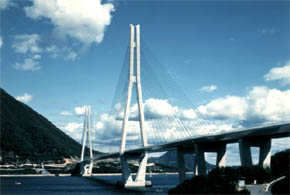|
MONTHLY NEWS June 1999 Walking Across the Seto Inland Sea |
 The
Nishi Seto Expressway, connecting two of Japan's four main islands--Honshu
and Shikoku--with bridges and highways over the western part of the Seto
Inland Sea, opened to traffic on May 1. The
Nishi Seto Expressway, connecting two of Japan's four main islands--Honshu
and Shikoku--with bridges and highways over the western part of the Seto
Inland Sea, opened to traffic on May 1. It's almost 60 kilometers (37 miles) long and connects the cities of Onomichi in Hiroshima Prefecture and Imabari in Ehime Prefecture. It includes 10 bridges spanning nine small islands in the Seto Inland Sea. The construction of the expressway began in 1975 and took 24 years to complete. The opening of the new route cuts travel time between the two cities by half to around 80 minutes. The ferry service that had served this route was discontinued on May 9. It's the last and farthest west of the three large-scale projects to connect Honshu and Shikoku. The first to be completed was the Seto Ohashi Bridge, which opened to traffic in 1988. And in April 1998, a bridge opened between Kobe and Awaji Island to complete a second Honshu-Shikoku link. Unlike the other two routes, the Nishi Seto Expressway has a path for cyclists and pedestrians so that people can enjoy the scenic beauty of the Seto Inland Sea more leisurely. The 10 bridges along the route are an attraction in themselves. You can see all kinds of bridges along the way, including an arch bridge, a triple suspension bridge spanning 4 kilometers (2.5 miles) across--the first of its kind in the world--and a 1,480-meter (0.9 miles) cable-stayed bridge--the world's longest. There are plans for hundreds of events over several months to celebrate the opening along the route. There is plenty to see, as the islands in the Seto Inland Sea are blessed by natural beauty and other sightseeing attractions.
Photo: The world's longest cable-stayed bridge, ready to carry people between Honshu and Shikoku.
(Honshu-Shikoku Bridge Authority) |
|

|